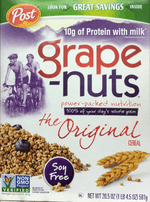Grape-Nuts

Grape-Nuts is a breakfast cereal developed in 1897 by C. W. Post, a former patient and later competitor of the 19th-century breakfast food innovator, Dr. John Harvey Kellogg. Despite the name, the cereal contains neither grapes nor nuts; it is made with wheat and barley. Post believed that glucose (which he called "grape sugar") formed in the baking process. This, combined with the nutty flavor of the cereal, is said to have inspired its name. Another explanation originates from employees at Post, who claim that the cereal got its name due to a resemblance to grape seeds, or grape "nuts." The cereal originally prepared by C. W. Post when developing the product was a batter that came from the oven as a rigid sheet. He then broke the sheet into pieces and ran them through a coffee grinder to produce the "nut" sized kernels.
Marketing

Grape-Nuts was initially marketed as a natural cereal that could enhance health and vitality, and as a "food for brain and nerve centres." [1] Its lightweight and compact nature, nutritional value, and resistance to spoilage made it a popular food for exploration and expedition groups in the 1920s and 1930s. In World War II, Grape-Nuts was a component of the lightweight Jungle ration used by some U.S. and Allied Forces in wartime operations before 1944.[2]
A 1939 ad campaign by cartoonist Walter Hoban continued his Jerry on the Job comic strip in Woman's Day magazine and daily newspaper comics pages.[3] General Foods also marketed Grape-Nuts through a comics-style advertising campaign (a trailblazer in this regard) featuring a character named Little Alby, who gained inordinate strength after consuming a bowl of Grape-Nuts.[4]
In the 1960s, advertising promoted Grape-Nuts as the cereal that "fills you up, not out". Brand users, particularly mother/daughter look-alikes, were shown engaged in fitness activities such as tennis, horseback riding, skiing, and swimming. Also appearing during the "fills you up, not out" campaign were Andy Griffith and Don Knotts as the characters from "The Andy Griffith Show," Sheriff Andy Taylor and Deputy Barney Fife. In reality, Grape-Nuts has a glycemic index of 71,[5] which is higher than that of table sugar (sucrose, GI 60).[6] Some nutritional researchers argue that high-glycemic index foods promote blood sugar spikes and might induce insulin resistance, thereby contributing to obesity (although this claim is controversial, and some researchers disagree).
This ad campaign produced one television commercial, which aired on television in 1968, that featured a catchphrase that became a target for numerous sketches and satires in media. Spanning the ensuing two decades and beyond, "Oh no, Mrs. Burke! I thought you were Dale!" was parodied on television variety show sketches, in the film The Kentucky Fried Movie and in many Mystery Science Theater 3000 episodes, fans continue to discuss the origin of this "riff" and have even developed products that feature the text, "I thought you were Dale."
A subsequent ad campaign generated another catchphrase, as Euell Gibbons became the spokesperson for the brand, promoting Grape-Nuts as the "Back to Nature Cereal". The line "Ever eat a pine tree? Many parts are edible" drew attention to the product from consumers, as well as from comedians.
Grape-Nuts is credited as the first widespread product to use a coupon in sales promotion when C.W. Post Company offered a penny-off coupon to get people to try their cereal in the late 1890s.
At one time, Grape-Nuts was the seventh most popular cold breakfast cereal, but sales declined as Post was sold from one company to another. Circa 2005 it held less than 1% of the market. About this time the formula was changed: The husks from milled grain were ground into the flour and the cereal was pitched as "whole grain," albeit at the cost of roughening the cereal's texture and detracting significantly from mouth feel. The addition of vitamins and minerals allowed it to qualify for food-stamp programs.[7] Ralcorp, the current owner of Post, has undertaken advertising campaigns to revitalize sales of the Post cereals.[8]

Ice cream
Grape-Nut ice cream is a popular regional dish in the Canadian Maritimes, the Shenandoah Valley, and New England. One origin story is that it was created by chef Hannah Young at The Palms restaurant in Wolfville, Nova Scotia in 1919. She created it when she ran out of fresh fruit to add to ice cream, and decided to throw in some cereal. It proved popular at the restaurant and the Scotsburn Dairy company began mass-producing the ice cream variety, and it sold across the region.[9] Variations of ice cream with Grape Nuts are also called brown bread ice cream.
See also
References
- ↑ "New York Historical Society". Retrieved 18 March 2015.
- ↑ Kearny, Cresson H. (Major), Jungle Snafus...And Remedies, Oregon Institute (1996), pp. 290–291
- ↑ "Gallery of Graphic Design". Retrieved 12 August 2012.
- ↑ "Funny Business: The Rise and Fall of Johnstone and Cushing," Hogan's Alley, 1999
- ↑ "GI Value of Grapenuts™ Breakfast Cereal". Retrieved 12 August 2012.
- ↑ "Glycemic Index Sugars". Retrieved 12 August 2012.
- ↑ Newman, B., Wall Street Journal, June 1, 2009
- ↑ Vranica, S., Wall Street Journal, March 26, 2009
- ↑ "Ice cream company scoops grapenut ice cream from Hannah Young." Hantsport News and Views. July 2010, pg. 12
Bibliography
- Jones, Evan (1981) American Food: The Gastronomic Story, Random House, Inc. ISBN 0-394-74646-5
External links
- Grape-Nuts US site
- Grape-Nuts Canada site
- Gallery of classic graphic design featuring Grape-Nuts cereals
- Burke Family Grape-Nuts TV Commercial Archives
- Straight Dope answer on "No grapes and no nuts"
| ||||||||||||||||||||||||||